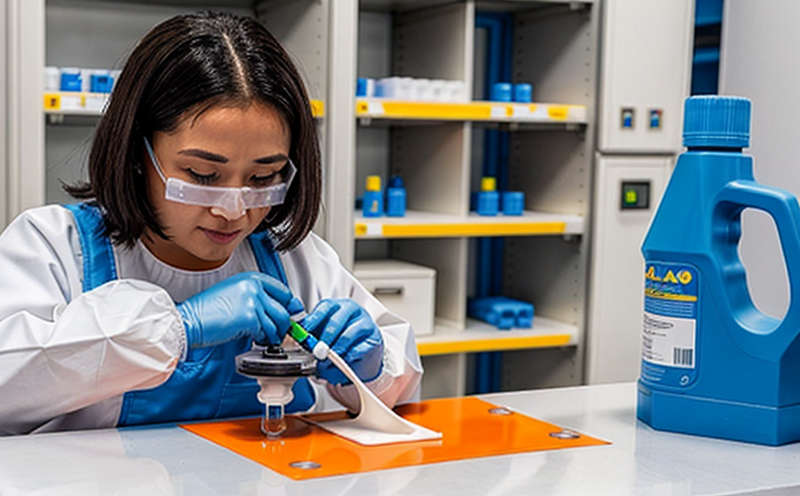ISO 11003 Creep Testing of Adhesive Joints with Nanomaterials
The ISO 11003 standard provides a standardized method for creep testing adhesive joints, which is critical in the evaluation and selection of nanomaterials for use in adhesives and sealants. This service focuses on the specific requirements and parameters outlined in ISO 11003 when dealing with nano additives incorporated into these materials.
Creep testing is essential because it helps determine how much a material will deform under constant stress over time, especially at elevated temperatures or prolonged exposure to environmental conditions. In adhesives and sealants containing nanomaterials, the addition of such particles can significantly alter both the mechanical properties and creep behavior of the adhesive joint.
The process involves preparing specimens with precisely controlled amounts of nano additives. These specimens are then subjected to a constant load in a specified temperature environment for extended periods. The resulting strain is measured over time, providing critical insights into how well the nanomaterials perform under long-term stress conditions.
Our laboratory adheres strictly to ISO 11003 guidelines to ensure accurate and reliable results. This includes using appropriate test fixtures that can accommodate small-scale joints typical of nano-adhesive applications. We also employ advanced instrumentation capable of monitoring minute deformations, ensuring precision measurements even at very low creep rates.
Understanding the creep behavior of nanomaterials in adhesives is crucial for several reasons:
- To ensure long-term durability and reliability of products
- To optimize formulations by identifying effective nano additives that enhance performance without compromising safety
- To meet regulatory requirements for materials used in critical applications like aerospace, automotive, and construction sectors
- To support research and development efforts aimed at creating next-generation materials with superior properties.
The data obtained from creep testing can be used to predict the service life of products containing nanomaterials. It also helps in understanding how these additives interact with other components within the adhesive or sealant, potentially leading to improved formulations and better product performance.
Our team works closely with clients throughout the entire process, from initial consultation on sample preparation through final analysis and reporting. By leveraging our expertise and state-of-the-art facilities, we provide comprehensive services that meet both current regulatory standards and future trends in nanotechnology.
Why It Matters
The importance of creep testing cannot be overstated when it comes to materials like adhesives and sealants containing nanomaterials. These substances are often used in high-stress environments where constant load-bearing is expected, making their ability to maintain structural integrity over time a key factor.
Creep testing allows manufacturers to assess the stability of joints formed by these materials under real-world conditions. This information is vital for ensuring that products meet safety standards and perform as intended during their entire lifecycle. For instance, in automotive applications, understanding how an adhesive joint ages can prevent premature failures that could lead to costly repairs or accidents.
Besides enhancing product quality, creep testing also plays a role in advancing technological innovations within the industry. By providing detailed insights into material behavior under various conditions, this type of testing supports ongoing improvements in formulation techniques and raw material sourcing.
In summary, creep testing serves as an essential tool for evaluating nanomaterials used in adhesives and sealants. Its significance lies not only in meeting regulatory expectations but also in driving continuous improvement towards more robust and efficient materials solutions.
Benefits
The benefits of conducting creep testing according to ISO 11003 are numerous, particularly for those involved in the development and production of adhesives and sealants containing nanomaterials. Here are some key advantages:
- Enhanced Product Quality: Creep testing ensures that the materials used in adhesive joints exhibit desirable mechanical properties over extended periods, enhancing overall product quality.
- Improved Safety: By identifying potential weaknesses early on, manufacturers can take corrective actions to avoid hazards associated with inadequate material performance.
- Regulatory Compliance: Adhering to international standards like ISO 11003 helps ensure that products meet necessary regulatory requirements.
- Innovation Opportunities: The insights gained from creep testing can inspire new formulations and improved manufacturing processes, fostering innovation within the industry.
- Economic Efficiency: Early detection of issues through thorough testing reduces costs related to production downtime and warranty claims.
- Environmental Responsibility: Understanding how materials behave under different environmental conditions promotes sustainable practices by encouraging the use of eco-friendly alternatives when appropriate.
In conclusion, creep testing according to ISO 11003 offers significant benefits across multiple dimensions, making it an indispensable practice for anyone involved in the production and development of adhesives and sealants containing nanomaterials.
Use Cases and Application Examples
The application of creep testing in the context of ISO 11003 is particularly relevant when dealing with nano additives incorporated into adhesives and sealants. This method can be used across various industries where long-term structural integrity and reliability are crucial.
- Aerospace Industry: In this sector, the use of high-performance adhesives is essential for joining composite materials in aircraft structures. Creep testing helps ensure these joints remain stable over extended flights under varying temperatures.
- Automotive Sector: Auto manufacturers rely heavily on adhesives to join various components like body panels and interior trim. By undergoing creep testing, they can verify that the joints withstand high loads without deforming excessively during regular use.
- BUILDING AND CONSTRUCTION: In construction projects requiring lasting bonds between concrete slabs or masonry units, knowing how an adhesive joint behaves over time is vital for long-term durability.
- MEDICAL DEVICES: Certain medical devices may employ adhesives in their assembly. Testing the creep behavior ensures that these joints remain intact despite prolonged wear and tear.
In each of these sectors, there are specific challenges related to the longevity and reliability of adhesive joints. Creep testing according to ISO 11003 provides a solution by offering precise data on how nano additives affect joint performance under different conditions. This information is invaluable for optimizing product design and ensuring compliance with industry standards.





